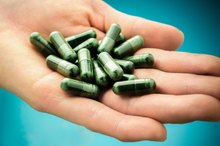What does fact checked mean?
At Healthfully, we strive to deliver objective content that is accurate and up-to-date. Our team periodically reviews articles in order to ensure content quality. The sources cited below consist of evidence from peer-reviewed journals, prominent medical organizations, academic associations, and government data.
- Office of Dietary Supplements; Chromium; 2005
- "Alternative Medicine Review"; The Safety and Efficacy of High-dose Chromium; D.W. Lamson and S.M Plaza; 2002
- "Alternative Medicine Review"; The Safety and Efficacy of High-dose Chromium; D.W. Lamson and S.M Plaza; 2002
The information contained on this site is for informational purposes only, and should not be used as a substitute for the advice of a professional health care provider. Please check with the appropriate physician regarding health questions and concerns. Although we strive to deliver accurate and up-to-date information, no guarantee to that effect is made.
Chromium Dinicotinate Glycinate Dangers
Chromium dinicotinate glycinate, or CDG, is a form of the mineral chromium that is used for its potential health benefits. CDG binds chromium with niacin and glycine to enhance the uptake of chromium in your body and is the preferred form of supplement manufacturers due to its increased bioavailability, according to the 2008 book "Essentials of Sports Nutrition and Supplements." Despite its potential benefits, several side effects with CDG supplementation may occur. Consult your physician before taking any nutritional supplement containing chromium or chromium dinicotinate glycinate.
If you are experiencing serious medical symptoms, seek emergency treatment immediately.
Chromium Toxicity
According to the Office of Dietary Supplements, the Institute of Medicine has not established a tolerable upper intake level, or UL, for chromium because there is not enough evidence related to its effects in high doses 1. However, the University of Maryland Medical Center states that high doses of chromium can inhibit insulin production and cause stomach irritation, itching, flushing, irregular heart rhythms and liver dysfunction.
Niacin Toxicity
Side Effects of GTF Chromium Supplements
Learn More
Niacin, or vitamin B-3, is cleaved from the chromium molecule in CDG once it is absorbed by your body. Excess niacin through over-supplementation of CDG and from other sources may cause:
- side effects
- including itching or burning of the skin
- headache
- blurred vision
- nausea
- vomiting
- diarrhea
- heartburn
- bloating
Other, more severe side effects of niacin oversupplementation include dizziness, rapid heartbeat and a yellowing of the skin, called jaundice.
Glycine Toxicity
For every molecule of chromium in CDG that is absorbed by your body, one molecule of glycine is also absorbed, according to the authors of "Essentials of Sports Nutrition and Supplements." Glycine is a naturally occurring amino acid in your body and is therefore generally well-tolerated, even in large amounts. However, the process of removing the glycine molecule from CDG occurs in the stomach and upper gastrointestinal tract, which can cause some digestive distress. The most common side effects of CDG supplementation include nausea, upset stomach, diarrhea and vomiting, which are usually associated with the breakdown of CDG into glycine and niacin.
- For every molecule of chromium in CDG that is absorbed by your body, one molecule of glycine is also absorbed, according to the authors of "Essentials of Sports Nutrition and Supplements."
- However, the process of removing the glycine molecule from CDG occurs in the stomach and upper gastrointestinal tract, which can cause some digestive distress.
Other Precautions
MSM & Weight Loss
Learn More
According to a 2002 study published in the "Alternative Medicine Review," chromium supplements, including chromium dinicotinate glycinate, chromium supplementation appears to be safe for most individuals 12. However, high doses of chromium supplements may interfere with some of your body's hormones, which can cause changes in blood sugar regulation and insulin sensitivity 1. Chromium supplements also promote the storage of chromium in various body tissues, especially your kidneys, which may be cause for concern if you suffer from kidney disease or renal failure, although no clear connection has been established 1.
Related Articles
References
- Office of Dietary Supplements; Chromium; 2005
- "Alternative Medicine Review"; The Safety and Efficacy of High-dose Chromium; D.W. Lamson and S.M Plaza; 2002
- Hua Y, Clark S, Ren J, Sreejayan N. Molecular mechanisms of chromium in alleviating insulin resistance. J Nutr Biochem. 2012;23(4):313-9. doi:10.1016/j.jnutbio.2011.11.001
- Cerulli J, Grabe DW, Gauthier I, Malone M, Mcgoldrick MD. Chromium picolinate toxicity. Ann Pharmacother. 1998;32(4):428-31. doi:10.1345/aph.17327
- Navarro VJ, Khan I, Björnsson E, Seeff LB, Serrano J, Hoofnagle JH. Liver injury from herbal and dietary supplements. Hepatology. 2017;65(1):363-373. doi:10.1002/hep.28813
- Food and Drug Administration. Food labeling: revision of the nutrition and supplement fact labels. Published May 27, 2016.
- U.S. Food and Drug Administration. Chromium 4 mcg/mL chromic chloride injection, USP. Updated April 2002.
- Brownley KA, Von Holle A, Hamer RM, La Via M, Bulik CM. A double-blind, randomized pilot trial of chromium picolinate for binge eating disorder: results of the Binge Eating and Chromium (BEACh) study. J Psychosom Res. 2013;75(1):36-42. doi:10.1016/j.jpsychores.2013.03.092
- National Institutes of Health: Office of Dietary Supplements. Chromium. Updated July 9, 2019.
- Chromium: Dietary Supplement Fact Sheet. National Institutes of Health. Updated July 9, 2019.
- Iovieno N, Dalton ED, Fava M, Mischoulon D. Second-tier natural antidepressants: Review and critique. J Affect Disord. 2011;130(3):343-357. doi:10.1016/j.jad.2010.06.010
Writer Bio
Joe King began writing fitness and nutrition articles in 2001 for the "Journal of Hyperplasia Research" and Champion Nutrition. As a personal trainer, he has been helping clients reach their fitness goals for more than a decade. King holds a Bachelor of Science in kinesiology from California State University, Hayward, and a Master of Science in exercise physiology from California State University, East Bay.









